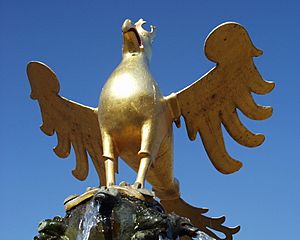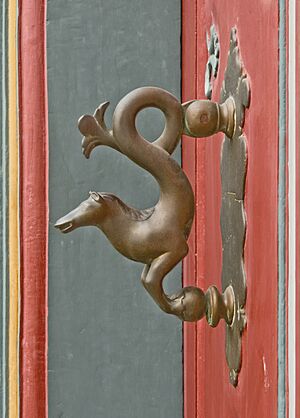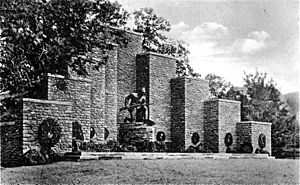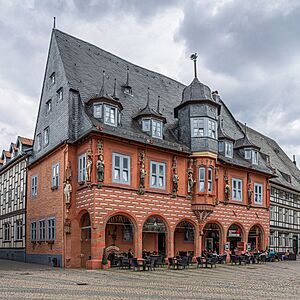Goslar facts for kids
Quick facts for kids
Goslar
|
|||
|---|---|---|---|
|
Clockwise from top: Imperial Palace of Goslar, the Siemenshaus, Market church of Sts. Cosmas and Damian, Rammelsberg, half-timbered houses in the Old Town and the market square with the old town hall and the Kaiserworth
|
|||
|
|||
|
Location of Goslar within Goslar district
 |
|||
| Country | Germany | ||
| State | Lower Saxony | ||
| District | Goslar | ||
| Subdivisions | 18 districts | ||
| Area | |||
| • Total | 163.88 km2 (63.27 sq mi) | ||
| Elevation | 255 m (837 ft) | ||
| Population
(2022-12-31)
|
|||
| • Total | 50,203 | ||
| • Density | 306.340/km2 (793.42/sq mi) | ||
| Time zone | UTC+01:00 (CET) | ||
| • Summer (DST) | UTC+02:00 (CEST) | ||
| Postal codes |
38640, 38642, 38644
|
||
| Dialling codes | 05321, 05325 | ||
| Vehicle registration | GS | ||
| Website | www.goslar.de | ||
| UNESCO World Heritage Site | |
|---|---|

View to the North with the Hildesheim downs in the background. Photograph taken from the Maltermeister Tower
|
|
| Part of | Mines of Rammelsberg, Historic Town of Goslar and Upper Harz Water Management System |
| Criteria | Cultural: i, iv |
| Inscription | 1992 (16th Session) |
| Extensions | 2010 |
| Area | 363.3 ha |
| Buffer zone | 376.1 ha |
Goslar is a super old and important town in Lower Saxony, Germany. It's nestled on the edge of the Harz mountains. Imagine a town with over 1,500 timber houses! That's Goslar's Old Town.
Both the Old Town and the Mines of Rammelsberg are so special that UNESCO has made them World Heritage Sites. This means they are important places for everyone in the world to protect. They show us a thousand years of history, especially about mining and how important Goslar was in the past.
Every year, Goslar gives out the Goslarer Kaiserring award to a famous artist. People even call it the "Nobel Prize" of the art world!
Contents
Exploring Goslar's Location
Goslar is right in the middle of Germany, about 40 kilometers (25 miles) south of Brunswick. It's also about 70 kilometers (43 miles) southeast of Hanover, the state capital.
The highest point in Goslar is the Schalke mountain, which is 762 meters (2,500 feet) tall. The lowest spot is near the Oker river, at 175 meters (574 feet). Goslar sits where the flat North German Plain meets the Harz mountains.
The flat areas around Goslar have rich clay soil, perfect for farming crops like sugar beet. To the south, the Harz mountains rise up, covered in thick forests. Several rivers flow through Goslar, including the Oker, Gose, and Abzucht. The Gose river, which the town is named after, starts in the mountains southwest of Goslar.
Towns Nearby
Goslar has several towns around it. Going clockwise from the north, these include Liebenburg, Schladen-Werla, Osterwieck, Bad Harzburg, Clausthal-Zellerfeld, and Langelsheim.
Goslar's Districts
Goslar is made up of 18 different areas, called districts:
- Old Town (the main part of the city)
- Rammelsberg with Siemensviertel and Rosenberg
- Georgenberg with Kattenberg
- Steinberg
- Sudmerberg
- Jürgenohl with Kramerswinkel
- Baßgeige
- Ohlhof
- Hahndorf with Grauhof (added in 1972)
- Hahnenklee with Bockswiese (added in 1972)
- Jerstedt (added in 1972)
- Oker (added in 1972)
- Immenrode (added in 2014)
- Lengde (added in 2014)
- Lochtum (added in 2014)
- Vienenburg with Wöltingerode and Wennerode (added in 2014)
- Weddingen (added in 2014)
- Wiedelah (added in 2014)
Goslar's Weather
| Climate data for Goslar, Niedersachsen | |||||||||||||
|---|---|---|---|---|---|---|---|---|---|---|---|---|---|
| Month | Jan | Feb | Mar | Apr | May | Jun | Jul | Aug | Sep | Oct | Nov | Dec | Year |
| Mean daily maximum °C (°F) | 2 (36) |
2 (36) |
7 (45) |
10 (50) |
16 (61) |
18 (64) |
21 (70) |
21 (70) |
17 (63) |
13 (55) |
7 (45) |
4 (39) |
11.5 (52.7) |
| Mean daily minimum °C (°F) | −2 (28) |
−3 (27) |
1 (34) |
3 (37) |
7 (45) |
11 (52) |
12 (54) |
12 (54) |
10 (50) |
6 (43) |
2 (36) |
0 (32) |
4.9 (40.8) |
| Source: World Weather Online | |||||||||||||
Goslar's Long History
People have been mining Iron ore in the Harz region since Roman times. The first signs of mining here are from the 3rd century AD! Goslar itself was first mentioned in a document in 979. It became very important when lots of silver was found at the nearby Mines of Rammelsberg.
Imperial Palace and Emperors
Goslar grew even more when emperors like Henry II started holding important meetings there in 1009. It became a favorite place for emperors, especially Henry III. He stayed at the palace many times and even had the Goslar Cathedral built. His son, Henry IV, was born in Goslar in 1050.
The emperors wanted to control the rich silver mines. This led to conflicts with local nobles. Goslar even became an "Imperial City," meaning it was directly under the emperor's rule.
Becoming a Free City
Over time, Goslar's importance as an emperor's home decreased. But the citizens gained more freedom! They got market rights in 1025 and formed a city council. In 1267, Goslar joined the Hanseatic League, a powerful group of trading cities. This helped the city grow through trade, not just mining.
Challenges and Changes
In the 1500s, Goslar faced tough times. There were conflicts with the Dukes of Brunswick-Lüneburg who wanted control of the mines. The city also became part of the Protestant Reformation, changing its religious practices.
The Thirty Years' War (1618-1648) was very hard on Goslar, causing economic problems. The city was even occupied by Swedish forces for a few years.
Modern Times
Goslar eventually lost its special "Imperial City" status in 1802 and became part of Prussia. Later, it was part of the Kingdom of Hanover and then back to Prussia after a war in 1866. The old Imperial Palace was restored during this time.
During the 1930s, Goslar became an important center for agriculture. It avoided heavy bombing during World War II. After the war, it was a British occupation zone and later a military town during the Cold War. The Rammelsberg mines, which had been active for over a thousand years, finally closed in 1988.
In 2018, a cool discovery was made! A bottled message from 1930, written by roofers, was found in the roof of the old Goslar Cathedral. One of the roofers who found it was actually the grandson of one of the original writers!
Goslar's Population Over Time
As of December 31, 2020, Goslar had 50,184 people living there (including Vienenburg).
|
|
|
|
(count: 31 December of each year)
Goslar's Government
Goslar has a town council that makes decisions for the city. The council members are elected by the people.
Town Council Members
For the period from November 1, 2016, to October 31, 2021, the seats in the town council were divided among different political parties:
- SPD: 14 seats
- CDU: 10 seats
- AfD: 3 seats
- FDP: 3 seats
- Greens: 3 seats
- Goslarer Linke: 2 seats
- BGL: 2 seats
- AfG: 1 seat
Goslar's Mayor
The head of the city government is the Mayor. Dr. Oliver Junk was the Mayor from 2011 to 2021. Since November 2021, Urte Schwerdtner from the SPD party has been the Mayor of Goslar.
Goslar's Sister Cities
Goslar is "twinned" with several cities around the world. This means they have special friendships and often exchange visitors or ideas.
 Arcachon, France (since 1965)
Arcachon, France (since 1965) Beroun, Czech Republic (since 1989)
Beroun, Czech Republic (since 1989) Brzeg, Poland (since 2000)
Brzeg, Poland (since 2000) Forres, Scotland, UK (since 1984)
Forres, Scotland, UK (since 1984) Ra'anana, Israel (since 2006)
Ra'anana, Israel (since 2006) Windsor and Maidenhead, England, UK (since 1969)
Windsor and Maidenhead, England, UK (since 1969)
Fun Things to See and Do in Goslar
Goslar has many interesting places to visit and fun events.
Theatres in Goslar
- The Odeon Theatre is the main theatre in town. It hosts plays and music shows.
- The Culture Power Station Harz is an alternative theatre in an old power station. It's run by volunteers and puts on modern plays and comedy. They also have the annual Goslar Fringe Culture Days in June.
Goslar's Museums
- Rammelsberg Mine Museum: Explore an ancient mine! It's part of the European Route of Industrial Heritage.
- Museum in the Kaiserpfalz: Learn about the medieval emperors in this reconstructed palace.
- Monks' House, Mönchehaus Museum: See cool modern art here.
- Goslar Museum: Discover more about Goslar's history.
- Museum in the Gothic Town Hall: Another place to learn about the town's past.
- Zwinger Tower and Dungeon: This museum teaches you about late medieval history in an old tower.
Places of Worship
Goslar has many churches and a mosque:
- Protestant-Lutheran churches: Marktkirche, Neuwerk, St Stephani, Zum Frankenberge, Gustav Adolf stave church (in Hahnenklee), Martin Luther Church, St Paulus (in Oker), St Georg, St Johannes, St Kilian (in Hahndorf), St Lukas, St Matthäus (in Jerstedt), St Peter.
- Baptist church: Christuskirche.
- Roman Catholic churches: St Jakobi (Goslar's oldest Romanesque church), Maria Schnee (in Hahnenklee), St Barbara, St Konrad (in Oker), Ss Benno & George, Abbey St George.
- Islamic Faith: Mosque of the Turkish-German Society, Goslar Mosque.
Sports and Outdoor Fun
Since Goslar is at the foot of the Harz mountains, there are lots of outdoor activities! You can go swimming, rock climbing, mountain-biking, and more.
The oldest sports club is MTV Goslar, founded in 1849. They have a football pitch and a gym. The local football team, Goslarer SC 08, even played in a higher league in 2009–10!
Festivals and Events
Goslar hosts many exciting events throughout the year:
- The Imperial Ring award: Given every year since 1975 to amazing artists like Henry Moore and Christo.
- Goslar International Concerto Days: Music performances in mid to late August.
- The Goslar Fair: A fun fair in early to mid-July.
- Annual Artisans market: See local crafts in the old town, usually in early August.
- Old Town Festival: A celebration of the old town in mid-September.
- Hanseatic Days: Celebrated in spring, often during the Easter holidays.
Goslar's Economy and Transport
Goslar is a busy town with shops, hotels, and businesses.
Shopping and Tourism
The town center is a great place to shop, with department stores, supermarkets, and boutiques. There's also a weekly market where farmers sell fresh local produce.
Tourism is a big part of Goslar's economy. Many hotels and bed and breakfasts welcome visitors. The town is also a popular place for conferences, with places like the Achtermann Hotel hosting events.
Jobs and Healthcare
Big employers in Goslar include H.C. Starck (a chemistry company), the tourism industry, and government jobs. Many people also travel to Salzgitter for work in car production or steel.
Goslar has a hospital, the Dr-Herbert-Nieper-Krankenhaus, which serves the wider Harz region. There are also many doctors and dentists in town.
Getting Around Goslar
Goslar has good connections for roads and trains. It's also a hub for getting into the Harz mountains.
- Roads: Two major highways, the A 7 and the A 395, are within 20 minutes of Goslar. The A 7 connects northern and southern Germany, while the A 395 links to Brunswick.
- Trains: Goslar is on the German Railway network, with lines connecting to Hanover, Halle, and Brunswick. The main train station is close to the town center.
- Buses: A central bus station at the railway station offers regular services to different places in the Harz mountains.
News and Media
The local newspaper is the Goslarsche Zeitung. There's also a regional radio station called Radio Okerwelle GoslarRadio that plays music and shares news.
Learning in Goslar
Goslar has a good education system:
- Primary Schools: Nine schools for younger children across the town.
- Grammar Schools: Two schools, the Christian-von-Dohm-Gymnasium and the Ratsgymnasium, prepare students for university.
- Intermediate Schools: Three schools (Andre-Mouton Realschule, Realschule Hoher Weg, Realschule Goldene Aue) prepare students for professional careers.
- Vocational Schools: Two schools (Hauptschule Oker and Hauptschule Kaiserpfalz) focus on practical skills.
- Special Needs School: A school for children with learning difficulties.
- Waldorf School: A public school that uses a special teaching method called anthroposophy.
For older students, there are four job-training colleges for crafts, economics, and healthcare. There are also two state vocational schools for part-time and full-time education in various fields like business, engineering, and science.
The closest university is the Engineering and Mining School in Clausthal-Zellerfeld, about 21 kilometers (13 miles) south. The famous University of Göttingen is about 80 kilometers (50 miles) south.
Adults can also continue learning at the Volkshochschule.
Famous People from Goslar

Many interesting people have connections to Goslar:
- Frederuna (887–917), who became a queen of France.
- Henry IV, Holy Roman Emperor (1050–1106), a powerful German emperor born in Goslar.
- The Siemens family, famous for their industrial work, has roots in Goslar since 1384. This includes Werner von Siemens, who founded the Siemens company.
- Maurice de Saxe (1696–1750), a famous French military leader.
- Albert Niemann (1834–1861), a chemist.
- Ernst Jünger (1895–1998), a German soldier and writer, lived in Goslar for a few years.
- Henning von Tresckow (1901–1944), a German military officer who was part of a group that tried to stop Hitler.
- Sigmar Gabriel (born 1959), a well-known German politician.
Sports Stars from Goslar
- Ernst Pistulla (1906–1944), a boxer who won a silver medal at the 1928 Olympics.
- Günther Brennecke (1927–2014), a field hockey player who won a bronze medal at the 1952 Olympics.
- Angelika Dünhaupt (born 1946), a luger who won a bronze medal at the 1968 Winter Olympics.
- Carola Hoffmann (born 1962), a field hockey player who won a silver medal at the 1988 Olympics.
- Mathias Hain (born 1972), a football goalkeeper.
- Aaron Hunt (born 1986), a footballer.
See also
 In Spanish: Goslar para niños
In Spanish: Goslar para niños


























